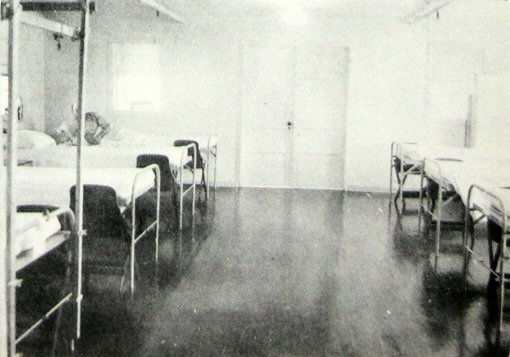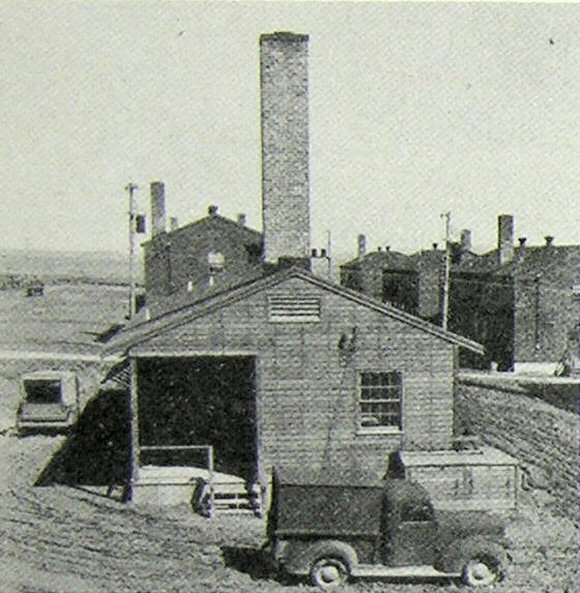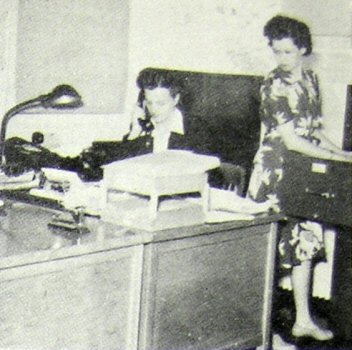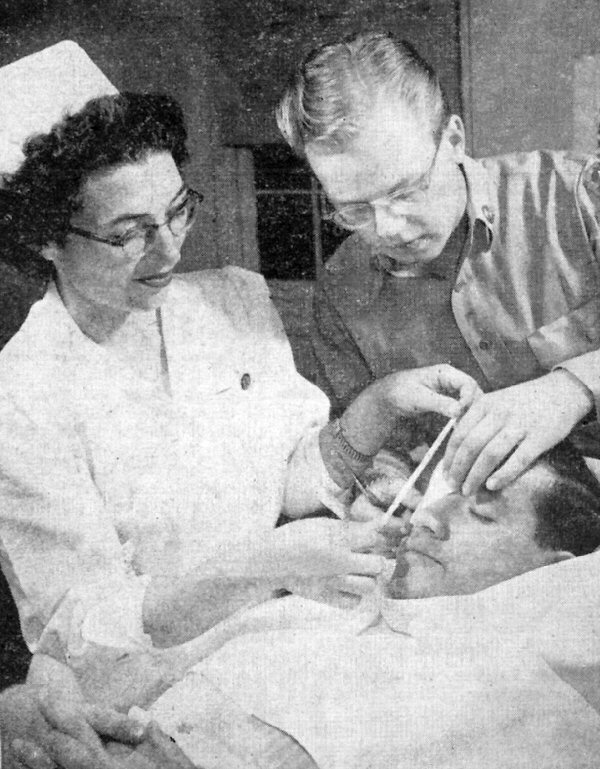

The Edgemont Tribune; Sept. 15, 1943; New Hospital At BHOD To Hold Grand Opening, Sept. 19, 1943.
The Edgemont Tribune; Sept. 29, 1943; open house and dedication of hospital on Sept. 19, 1943, 1500 people attended.
An oxygen tent has been received and is now available for use at the Station Hospital. This piece of equipment is especially valuable for combating pneumonia and the effects of phosgene gas. It adds one more item to the equipment of our up-to-date hospital.
A free immunization clinic is being held at the hospital for all the children on the area, and parents are urged to have children immunized.
The Edgemont Tribune; March 14, 1945; The entire personnel has been receiving instructions on the operation of the Emerson Resiscitator received this week which was purchased through the Employee Welfare Association. This resuscitator will be operated by the Fire Department and will be available for anyone needing artificial respiration within a few minutes time. It is particularly valuable in case of carbon monoxide poisoning, electric shock, or drowning.
| BHODian | pages 21-24. | April 1945 |

The present hospital with a capacity of 54 beds, a fully equipped surgery, obstetrical, X-ray, dental, laboratory, pharmacy, out patient department, medical supply and heating plant was opened September 27, 1943.
In addition to the patients admitted to the hospital a average of 100 office patients are treated daily by physicians and nurses.
The hospital staff is now composed of 44 people, including four physicians, two dentists, six registered nurses, four nurse's aides, one laboratory technician, five medical detachment enlisted men, and twenty other civilian employees. Two ambulances are in constant service.

|

|
| OPERATING ROOM | WARD NO. 1 |

TOWER VIEW OF HOSPITAL

|

|
| DENTAL OFFICE | PRESENT STAFF |
Terteling and Son, contractors for the building of the Black Hills Ordnance Depot, contracted with the Black Hills Clinic, Dr. F. W. Bilger and Dr. J. M. Butler, Hot Springs, South Dakota, to make all pre-employment examinations, to care for all injuries and to treat all employees and their dependents. On May 5, 1942, the Black Hills Clinic opened its Provo office in a tar paper covered building, 14 X 14 feet, formerly used to store cement.

ORIGINAL FIRST AID STATION
Two physicians and two registered nurses were employed. No eating place or sleeping quarters being available, the doctors and nurses drove back and forth from Hot Springs daily. This was during the rainy season, the longest and hardest in the history of the country. There being no gravel or oiled roads on the project, it was necessary many times to meet the doctors and nurses at Provo with a bulldozer or tractor and transport them to the project.
At the time of the opening of the first aid station, not a single building on the Depot had been completed. It had been promised that the Clinic, the Dispensary and hospital building now occupied by housing, would be completed first, but due to weather, mud and lack of supplies, it was not finished until July 15th. However on June 22nd, the clinic staff moved in with only part of the floors laid, with no water, lights or heat. Finally a small pipe line was laid on the surface of the ground and water was pumped from a water tank on a truck with water hauled from Edgemont. At this time all water for drinking, domestic and commercial use was hauled from Edgemont. Electricity was finally obtained from a small portable outfit.

THE FIRST INFIRMARY
When the hospital was finally completed, three doctors and at times four, three nurses, three nurse's aides and two record clerks were employed. The hospital was fully equipped with the exception of the laboratory. All severely injured or ill patients were sent to the hospital at Hot Springs.
The hospital had eight beds for men and four for women. At one time 7,500 men were employed on the project. As many as 350 were given pre-employment examination in 24 hours. The contract with the Black Hills Clinic terminated October 31, 1943, when the general contractor had completed the most of their work, and their payroll had dropped to less than 1,000.
The first dispensary under Ordnance opened December 1942, in the present Fire and Guard Building. The personnel consisted of one doctor and two regisitered nurses, Dr. Ramsey, Miss Velma Weatherly and Mrs. Eileen Peters. Medical supplies were very limited. All employees were immunized for typhoid fever and tetonus, and vaccinated for smallpox. All minor injuries were treated, all major illnesses and injuries were taken by ambulance to Hot Springs. In February, 1943, a First Aid Station was established in the change house at the Field Office to give immediate care to all employees of the Magazine Area. A registered nurse and special ambulance were assigned, and here all were treated. Those needing further care were brought to the Dispensary. An average of 350 people report to the First Aid Station every month.

FIRST AID STATION - MAGAZINE AREA

|

|
| HOSPITAL AMBULANCE | OFFICE |

|

|
| CONVALESCENT WARD | HOSPITAL ENTRANCE |

|

|
| OUT-PATIENT DEPARTMENT | ELIZABETH ANN FOX - 1st BABY BORN AT HOSPITAL |
| Vol. 9 No. 25 | page 10 | Dec. 20, 1946 |
Due to the shortage of personnel at the Hospital, house calls by nurse or doctor cannot be made as easily as before. House calls, other than suspected contagious diseases or emergencies, will not be made unless the patient is absolutely bedridden. It is your responsibility to get to the Hospital for treatment when symptoms first appear. Transportation is available by calling the Hospital. (Phone #33.)
JOHN A. STERNER
Captain M. C.
Post Surgeon
| Vol. 1 No. 29 | pages 1 & 6 | July 25, 1952 |

A general view of the U. S. Army Hospital at Igloo. Hospitalization and out-patient treatment is afforded residents at nominal cost.
The U. S. Army hospital was constructed shortly after the completion of the Black Hills Ordnance Depot and was utilized until 1946 on a full scale, staffed primarily by military personnel. Due to the demobilization of the Armed Forces in 1946 and 1947, the hospital was on a constant downgrade in personnel, equipment and type of treatment rendered. Finally, in April of 1949, the hospital was closed and a dispensary was operated, primarily to render treatment for industrial injuries and illness.
However, because of local requirements, the hospital was re-established in January of 1950 and has been gradually increasing its capabilities ever since. Today, the hospital has an authorized staff of 22 persons, including three doctors and seven nurses.
A patient today can be confident of receiving the best medical, obstetrical and minor surgical care possible within our professional and administrative allowances.
A doctor alone is many times helpless to classify and treat an illness or injury without the help of others, nor can he perform an operation without competent assistance. The doctors of the U. S. Army hospital are able to obtain from its laboratory any type of chemical, bacterial or parasitic test desired; from its pharmacy they can obtain any drug solution, compound, salve or ointment; and from its radiology section, almost any desired X-ray film can be taken.
These and many more assets are found in the hospital facilities. With the constant development and equipment used in medicine, the Medical Service of the United States Army has at its access a source far greater than any other of its type. It spends millions of dollars yearly in its own advancement, and assures the dispersment of all new knowledge and supplies through the use of military and civilian publications. Further, it establishes schools and courses of instruction for its professional and administrative personnel to assure that the latest data is dispersed to the smallest unit.
From the later, it can be seen that a constant evolution prevails to maintain a level of medical treatment equal or better than that of any other.
The cost of treatment relative to that in civilian installations is quite inexpensive. At the beginning of each fiscal year, the Department of the Army publishes current reciprocal rates to be charged for both "Out Patient" treatment and hospitalization. It is from these directives that the rates of charge are established at this installation. The rate of charge for fiscal year of 1953 has increased from $13.25 to $14.25 per day for hospitalization, but remains the same for "Out Patient" care.
Cure for industrial injuries or illness is of basic importance at this hospital. All type cases are treated and hospitalized on a compensatory basis. Those persons requiring advanced surgery are referred to compensation doctors at Hot Springs, S. Dak.

Show here are Nurse Marjorie Grabow and Cpl. Don Axelson administering first aid to a patient at the Black Hills Ordnance Depot's First Aid Station. They are applying a bandage to the patient's eye after removing a foreign object.
Minor injuries occuring on the job are treated at the First Aid Station, while complicated cases are taken to the hospital.
The hospital is responsible to the Commanding Officer of the Black Hills Ordnance Depot for inspections of the depot with respect to sanitation. A weekly inspection of all facilities and concessions is made, plus sanitary inspections of housing.
In conjuntion with the Post Engineers, the hospital assists in the control of insects, sanitary deficiencies and further assists the Safety Director in the detection of physical hazards in the working areas, as well as sanitary working conditions.
Working a 24-hour day, seven days a week, the hospital offers direct medical service to all military, civilian employees and their dependents. It maintains a doctor on call and a nurse on duty after normal duty hours to care for those who are sick or injured. Its First Aid Station operates two shifts in conjunction with those in the restricted Area. Its medical technicians are subject to call on demand.
It has beds available for every need, and in emergencies is prepared to perform most any surgical or medical treatment.
In case of need, there are two new ambulances readily available, one a Cadillac Metropolitan, and the other a GMC, both capable of carrying four patients.
With the history of healing the sick and caring for the needy, progressing over thousands of years, the newly acheived fields in medicine can be proud of their great advancements. Through these strides all mankind has gained, and continues to gain from the pledged efforts of the few who endeavor to open the road to riches of life through health of mind and body. The illnesses of man are great, but greater still is the desire of the members of the Army Medical Service and its civilian colleagues to give to their fellow man those riches.
We of the U. S. Army Hospital wish to express our appreciation and gratitude to those, who, during the hospital's short history, have given so much to its advancment in its professional quality and in its physical standards.
| Vol. 2 No. 17 | page 1 | Apr. 24, 1953 |
Col. H. G. Hamilton, Depot commander, was notified this week by Fifth Army Headquarters that four civilian spaces in the U. S. Army Hospital here will be abolished. It will be necessary to discontinue the positions of X-ray technician, receptionist and two nurse positions as part of the overall economy move by the Defense Department.
The hospital will still maintain the ward for in-patient treatment as well as the out-patient clinic.
The Depot commander said a firm feeling had been received for the balance of the Fifth Army activities at BHOD as Fifth Army spaces and funds are primarily used in Post Engineers and the Motor Pool. Sufficient money and spaces have been secured to permit continued employment of all workers now paid with Fifth Army funds in these two activities.
| Vol. 2 No. 45 | page 5 | Nov. 6, 1953 |
"Operations IMP" begins Monday at the depot with 100 percent of the employees slated to have a part in the project.
IMP, short for Industrial Medical Program, will take on a new aspect with the beginning of a physical examination program scheduled to reach all employees during the coming year. The Commanding Officer, Paul N. Wickens said Wednesday in a letter addressed to all employees, "To assist you in determing the state of your health, the U. S. Army Hospital will institute a periodic medical examination as a part of the depot industrial medical program. The objectives of this program are to assist all employees in maintaining their best physical condition, prevent development of acute or chronic diseases or disabilities during employment and to insure proper utilization of employees by reduction of time lost through illness or injury."
The Commanding Officer expressed concern over the number of sudden illnesses and deaths among depot workers during the past year and suggested that the program of physical examinations in the future might reveal a number of illnesses before they become serious. Capt. Leon Gordon, Hospital Commander, will be the overall director of the Industrial Medical Project. He said the Industrial Medical Program of the depot is similar to that of large industrial concerns. Dupont, Ford Motor Company and Bethlehem Steel were given by the Doctor as examples of companies who offer their employees periodic physical checkups. Capt. Gordon said the examination would include a chest x-ray, urinalysis, check of blood pressure, heart, eyes, ears, nose, throat, and of the adbominal region. Also included will be a hemoglobin and sedimentation test of the blood. Captain Gordon expressed the belief that the examination, if secured privately, would cost at least $25.00. No charge will be made here and employees will still be permitted to secure the examination from their own personal physician if they desire.
Employees will be notified by their supervisors one to three days in advance of the date of the examination. The general schedules by Divisions will be published from time to time by the Personnel Office.
| Vol. 2 No. 47 | pages 1 and 2 | Nov. 20, 1953 |
The Industrial Medical Program, or "Operation IMP", has been in effect for nearly two weeks and, according to Captain Leon Gordon, the Hospital Commanding Officer, is proving to be an unqualified success.
To date 53 employees have taken this complete medical examination. Included were persons from the Civilian Personnel Office, Fiscal Office, Management Office, Purchasing Branch, Adjutant's Office and Mail and Records Branch. It is planned to take care of approximately 30 employees weekly and the scheduling will continue until all employees in every division, branch and office have the opportunity to be examined.
Employees are notified by their supervisors at least one day in advance of the scheduled appointment. At that time employees receive a Medical History Report which they are to complete and present at the hospital at time of appointment.
The programs object is to assist all employees in maintaining good health throught the practice of preventative measures and acceptance of the policy has been excellent, according to Capt. Gordon. Comments from employees who have completed the physical examination indicate "its a wonderful feeling to know one's condition. It sure sets your mind at ease."
Any employee desiring to be examined by their own physician may do so and can obtain the necessary medical examination form by contacting the Civilian Personnel Office.
The staff at the U. S. Army Hospital are to be commended for the thoroughness and efficiency of examinations and the courteous treatment accorded the employees being examined.
Welcome To Black Hills Ordnance Depot; (early 1960's)
Medical Facilities
(photo of hospital)
The hospital provides all medical care, within the limits of its facilities, to all military and civilian personnel resideing within the depot, including dependents. Civilian personnel using this service pay the standard fees established by the U.S. Army Medical Corps.
Employee Handbook; (early 1960's)
(pg. 19); 22. FEDERAL HEALTH BENEFITS PROGRAM
The Federal Employees Health Benefits Plan is a voluntary program for full time career or career-conditional employees, partly paid for by Government as your employer, to protect you and your family against costs of illness and accident.
Here is what the plan offers you:
+ Chance to join a group health benefits plan, with better rates and better protection than you can get as an individual.
+ No medical examination, age, or physical requirements.
+ Easier payments, through regular payroll deductions.
+ Government contributions toward membership cost.
+ "Catastrophic" benefits (in some plans) that go beyond usual costs of surgery and hospitalization, to help you finance chronic, long-term, or serious illness or accident.
+ Choice of plans, to provide the kind and amount of protection you actually need and want.
+ Continued protection after retirement, if you meet the length of service and other requirements.
+ The peace of mind that goes with a good program of health protection.
(page 20)
Government, as your employer, will pay part of the cost of your membership The amount you pay will depend on the price of the particular plan you join. Through payrool deductions, you will pay the difference between the amount the government contributes and the amount your plan costs.
You can take out an insurance plan for yourself. You may also include your wife (or husband) and unmarried children under 19; adopted children and stepchildren under 19, too, in most cases; certain disabled children over 19. You cannot include your parents or other relatives, even though they live with you and are dependet on you.
There are several different kinds of plans. Two of them are common through the entire Federal Service. The two common plans are:
Government-wide Service Plan, and a Government-wide Indemnity Plan. Each of these plans has two options, one offering a higher level of benefits at a higher cost, and the other offering a lower level of bendfits at a lower cost.
You may be wondering. "How much of my medical costs will the program pay?" This depends on the plan you choose. Most plans will cover some but not all of the costs of hospitalization and of surgical and maternity care. The kinds of expenses covered, and how well they are covered, will vary, however. You should compare the available plans very carefully before you decide which one to join.
At certain times, designated by the Civil Service Commission, you can change from one plan to another. Your membership in the health plan continues when you retire if:
(1) You get an immediate annuity; and
(2) You retire after completing 12 years of service or on disability; and
(3) You have been enrolled in the program during all of your service from the time of your first opportunity to join or for the 5 years of service before you retire.
The Personnel Office has booklets about the program and each plan. If you have any questions, or need literature, see a representative of the Personnel Office.
(page 28); 31. MEDICAL SERVICES
All employees, regardless of type of appointment, are given a medical examination at the time of entry on duty, to determine their physical fitness for the job to which they are being appointed. This examination is given by a physician who has been apporved to give examination for Federal appointment.
As a part of the Depot Health Service Program you will be given physical examinations free of charge at the station hospital at least once every two years. If you are age 60 or over, an examination is given yearly if you are doing heavy work. There are some other groups of employees such as firefighters, who must also be examined each year. Physical examinations are given to let you know of any deficiencies which should be corrected in your own best interest and to insure that you are able to physically perform the duties assigned. The periodic physical examination can also be given by your Doctor at your expense.
An employee may be given a physical examination at any time to determine his (page 29) fitness for continued employment whenever his supervisor discovers defects or weaknesses which develop after his original appointment.
It is a basic responsibility of all employees to keep mentally and physically fit. In addition to examinations given under the Industrial Health Program employees are encouraged to have periodic physicals with their personal physician as wekk as periodic dental and eye examinations.
| Edgemont Herald-Tribune | page 2 | Aug. 10, 1961 |
H. Kruse of the Kruse Air Conditioning Company, Sioux Falls, So. Dak. attended a pre-construction conference, held at Black Hills Ordnance Depot to discuss the contract for air conditioning the U.S. Army Hospital at the Depot. Kruse was successful bidder for the project.
| Edgemont Herald-Tribune | page 1 | Aug. 17, 1961 |
In answer to an inquiry made by the Herald-Tribune, relative to the Army's future hospital planning, Black Hills Ordnance Depot Commanding Officer Col. John R. Bailey, Jr., referred to an article which appeared in a Army Navy Air Force Journal for July 1, 1961.
The article covered the long range planning of Army Surgeon General Lt. General Leonard D. Heaton and stated, "The Army will seek construction of 24 new hospitals on a schedule of three each year."
The hospitals will be called "Army Health Centers" and presumably will be not be subject to Budget Bureau restrictions on the size of military hospitals. The Budget Bureau restrictions relate the total space of a hospital to the number of in-patients it is designed to service.
"Each Army Health Center," the article stated, "will be a permanent structure housing all health facilities of an installation. At large posts, auxiliary buildings in troop areas will serve as clinics."
"New 'Army Health Centers' which are needed within in the next two years, Army officials say, are at Fort Leonard Wood, MO; Fort Sill, OK; Letterman General Hospital, San Francisco; Fort Hood, Texas; White Sands Missile Range, NM; and Fort Rucker, Ala."
"Other locations at which hospitals should be built through fiscal year 1969, include Fort Devens, Mass.; Fort Jay, N.Y.; Fort Jackson, SC; Fort Stewart, Ga.; Fort Gordon, Ga.; Fort McPherson, Ga.; Camp Leroy Johnson, La.; Fort Campbell, Kentucky; Fort Benjamin Harrison, Ind.; Black Hills Ordnance Depot, SD; William Beaumont General Hospital, El Paso; Fort Huachuca, Ariz.; Navajo Ordnance Depot, Ariz.; Tooele Ordnance Depot, UT; Fort Lawton, WA; Sierra Ordnance Depot, CA; Fort Ord, CA; and Fort McArthur, CA."
change of mission, on July 1, 1963 the status was changed from hospital to dispensary.
The GPS coordinates for the Post Hospital are 43.200667, -103.868784. (entrance)



